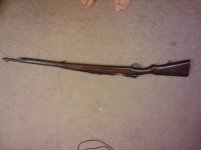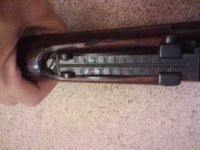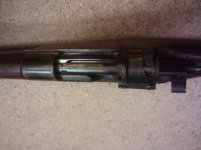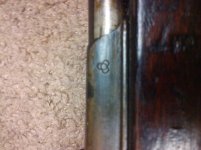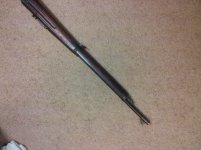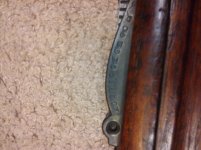I was hoping someone could tell me what this rifle is and where it is from...i found it going through some of my grandfathers stuff in his basement. It has some different language markings on it....any info would be helpful.
You are using an out of date browser. It may not display this or other websites correctly.
You should upgrade or use an alternative browser.
You should upgrade or use an alternative browser.
Please help identify this rifle...
- Thread starter franco
- Start date
Mike Irwin
Staff
I THINK it might be a Siamese Mauser made in Japan...
http://www.surplusrifle.com/shooting/siammauser/index.asp
http://www.surplusrifle.com/shooting/siammauser/index.asp
It is a Siamese Mauser, Model 1903; the front band and the Siamese markings are distinctive. While some of those may have been made in Germany (I have never seen one that was) most were made by Tokio Arsenal (the "rings" sign) in Japan. The chakra (wheel symbol) seems to have been removed from the receiver ring and it looks like the dust cover is missing.
They are basically a Model 98 Mauser, but have several modifications. The main one was the magazine, which had to be changed for use with the Siamese Type 45 (1902) 8mm cartridge, a rimmed round. Later, they were altered to use the Type 66 (1923) round, also a rimmed 8mm but using a different case shape and a pointed bullet.
Other differences from the standard Model 1898 were the foreend cap and the dust cover. Unlike the Japanese Arisaka dust cover, the Siamese one did not move with the bolt; it could be pushed forward to clear the action or back to cover it.
There is some question as to why Siam (now Thailand) turned to Japan for Mausers, but it was likely that they got a good deal from the Japanese, eager to expand their influence in East Asia and knowing that influence follows arms.
The ammunition is nearly impossible to obtain in the U.S. but the magazine allowed a fairly easy conversion to .45-70 and many were rebarrelled to that caliber.
Jim
They are basically a Model 98 Mauser, but have several modifications. The main one was the magazine, which had to be changed for use with the Siamese Type 45 (1902) 8mm cartridge, a rimmed round. Later, they were altered to use the Type 66 (1923) round, also a rimmed 8mm but using a different case shape and a pointed bullet.
Other differences from the standard Model 1898 were the foreend cap and the dust cover. Unlike the Japanese Arisaka dust cover, the Siamese one did not move with the bolt; it could be pushed forward to clear the action or back to cover it.
There is some question as to why Siam (now Thailand) turned to Japan for Mausers, but it was likely that they got a good deal from the Japanese, eager to expand their influence in East Asia and knowing that influence follows arms.
The ammunition is nearly impossible to obtain in the U.S. but the magazine allowed a fairly easy conversion to .45-70 and many were rebarrelled to that caliber.
Jim

